
The Rent Curse: Natural Resources, Policy Choice, and Economic Development PDF
Preview The Rent Curse: Natural Resources, Policy Choice, and Economic Development
OUPCORRECTEDPROOF–FINAL,3/11/2018,SPi The Rent Curse OUPCORRECTEDPROOF–FINAL,3/11/2018,SPi OUPCORRECTEDPROOF–FINAL,3/11/2018,SPi The Rent Curse Natural Resources, Policy Choice, and Economic Development Richard M. Auty and Haydn I. Furlonge 1 OUPCORRECTEDPROOF–FINAL,3/11/2018,SPi 3 GreatClarendonStreet,Oxford,OX26DP, UnitedKingdom OxfordUniversityPressisadepartmentoftheUniversityofOxford. ItfurtherstheUniversity’sobjectiveofexcellenceinresearch,scholarship, andeducationbypublishingworldwide.Oxfordisaregisteredtrademarkof OxfordUniversityPressintheUKandincertainothercountries ©RichardM.AutyandHaydnI.Furlonge2019 Themoralrightsoftheauthorshavebeenasserted FirstEditionpublishedin2019 Impression:1 Allrightsreserved.Nopartofthispublicationmaybereproduced,storedin aretrievalsystem,ortransmitted,inanyformorbyanymeans,withoutthe priorpermissioninwritingofOxfordUniversityPress,orasexpresslypermitted bylaw,bylicenceorundertermsagreedwiththeappropriatereprographics rightsorganization.Enquiriesconcerningreproductionoutsidethescopeofthe aboveshouldbesenttotheRightsDepartment,OxfordUniversityPress,atthe addressabove Youmustnotcirculatethisworkinanyotherform andyoumustimposethissameconditiononanyacquirer PublishedintheUnitedStatesofAmericabyOxfordUniversityPress 198MadisonAvenue,NewYork,NY10016,UnitedStatesofAmerica BritishLibraryCataloguinginPublicationData Dataavailable LibraryofCongressControlNumber:2018945756 ISBN 978–0–19–882886–0 Printedandboundby CPIGroup(UK)Ltd,Croydon,CR04YY LinkstothirdpartywebsitesareprovidedbyOxfordingoodfaithand forinformationonly.Oxforddisclaimsanyresponsibilityforthematerials containedinanythirdpartywebsitereferencedinthiswork. OUPCORRECTEDPROOF–FINAL,3/11/2018,SPi Preface Morethantwodecadesofstatisticalanalysishavefailedtoresolvethecauses of the resource curse or even determine whether the phenomenon exists or not. Weemploy rent cycling theory toundertake a more subtle approach to theresourcecursethanthatachievedbystatisticalstudiestodate.Wedosoby analysing the political economy of windfall gains from natural resource exploitation in two case study countries and then applying the findings to the principal global developing regions. We construct two stylized facts models of rent-driven growth to show that: (i) the resource curse exists but thatitiscausedbypolicyfailure,sothatitisnotadeterministicphenomenon; (ii) the global incidence of the resource curse varies over time and by com- modity;and(iii)theresourcecurseisavariantofawiderrentcursethatcan be caused by windfall revenues from foreign aid (geopolitical rent), worker remittances (labour rent), or government manipulation of relative prices (regulatoryrent). The basic premise of rent cycling theory is that low rent incentivizes the elite to grow the economy in order to become wealthy, whereas high rent encouragestheelitetosiphonawayrentforimmediateself-enrichmentatthe expense of long-term economic growth. The contrasting incentives trigger systematicdivergenceinpolicythatresults in twodistinctivetrajectories for structuralchange.Morespecifically,lowrentencouragestheelitetogrowthe economybyallocatinginputsefficiently,whichalignstheeconomywithits comparativeadvantageinlabour-intensiveexportsanddrivesrapidandrela- tivelyegalitarianeconomicgrowthalongwithincrementaldemocratization. In contrast, high rent elicits contests among the elite to capture the rent for immediatepersonalenrichmentanddiscouragesthedistributionofwealthin a fair and sustainable manner. This causes the high-rent economy to absorb rent too quickly and to experience Dutch disease effects, which lead to the expansion of a subsidized urban sector whose burgeoning demand for rent eventually outstrips supply and causes a protracted growth collapse, with attendant political destabilization. The resulting high-rent staple trap trajec- tory fails to achieve competitive diversification and consequently intensifies rentdependence. OUPCORRECTEDPROOF–FINAL,3/11/2018,SPi Preface Our findings carry significant implications for development research. We trace rent flows from their extraction, through their deployment, to their impact on the political economy. We thereby respond to recent calls by leadingeconomistssuchasStiglitztostudythedistortingimpactsofrenton economic growth. Our low-rent model identifies the importance to sustain- able (productivity-driven) long-term development of: rent scarcity in incen- tivizing the elite to pursue growth-oriented policies; Lewis’s labour market turning point, in triggering self-sustaining competitive diversification of the economy; and early passage through the demographic cycle, for achieving rapidandegalitarianpercapitaGDPgrowth.Incontrast,thehigh-rentstaple traptrajectoryrisksincentivizingcontestsamongtheeliteforrentthatcause overrapiddomesticrentabsorptionandDutchdiseaseeffects.Thispostpones thelabourmarketturningpointandprecludesthebenefitsthatthelow-rent economy derives from its singular pattern of competitive structural change. Instead,thehigh-renteconomydiversifiesintorent-subsidizedactivity,which isnotsustainable. Ourtwobasicstylizedfactspoliticaleconomymodelsoflow-rentandhigh- rentgrowthusefullycomplementstatisticalstudiesoftheresourcecurse.The statistical studies pursue rigour at the cost of oversimplifying the factors at work,whereascasestudiesallowforamorenuancedexplanationofresource curse effects. For example, we identify significant fluctuations in the global intensityofresourcecurseeffects,linkedtohistoricalchangesindevelopment policyfashionssincethe1950s.Wealsoshowthatresource-pooreconomies canexhibit‘resourcecursesymptoms’duetoflowsofgeopoliticalrent,labour rent,andregulatoryrentthatcanrivalresourcerentsintheirmagnitudeand consequences. Moreover, commodities differ in their vulnerability to rent curseeffects. Our research identifies the misallocation of inputs arising from the wide- spreadpost-warpolicybiasinfavourofmanufacturing-drivengrowth,which invariablyoccurredattheexpenseofthepotentialcontributionstoeconomic development from the agriculture and service sectors. The policy was espe- ciallydisadvantageousforsmalleconomies,whichlackedsufficientdomestic demand to sustain factories of minimal viable size. Invariably, rent was deployed to protect inefficient import substitution industry rather than the dynamic and competitive manufacturing that low-rent economies achieved. Instead, import substitution policies invariably degenerated into a source of regulatoryrentthatconsolidatedrent-seekingconstituenciesthatlockedthe economyintoastapletrap.Finally,scholarsofdevelopmenthavefrequently underestimated the flexibility of the plantation as an institution, which in countries as diverse as Malaysia, Mauritius, and Guyana has proved to be adaptabletomajorchangesinthepoliticaleconomy. vi OUPCORRECTEDPROOF–FINAL,3/11/2018,SPi Preface We draw upon Mauritius and Trinidad and Tobago to illustrate the argument because they exhibited remarkably similar initial conditions at independenceinthe1960s,apartfromtheirmineralendowments.Wedem- onstrate thatTrinidadand Tobago has experiencedresourcecurse effects:its high-rent economy traced a staple trap development trajectory and experi- encedaprotractedgrowthcollapsethrough1981–93.Moreover,Trinidadand Tobago has yet to diversify awayfrom rent-driven growth into productivity- driven growth, upon which sustainable long-term gains in welfare depend. Trinidad and Tobago shares this unsatisfactory outcome with other rent- addicted economies including the Gulf States, Russia, and Venezuela. We use Mauritius as a counterfactual to illustrate the low-rent trajectory that is alsoassociatedwiththefourAsianDragons,aswellasChina,Bangladesh,and Vietnam, and is likely to be pursued by sub-Saharan African economies as moreandmoreofthemarerenderedland-poorbypopulationgrowth. WetracetheoriginsofTrinidadandTobago’sstrongaddictiontorenttoits earlyrelianceonsugar.WealsodemonstratetheriskstoTrinidadandTobago of relying upon its current strategy of gas-based industrialization, which is a minimal diversification from dependence on hydrocarbon rent. Rather, we proposereformofthepoliticaleconomytocapitalizeonrecentglobalgrowth insophisticatedserviceexportsandvaluechains,whichoffernewopportun- ities to achieve productivity-driven development that is sustainable. But a precondition for success is that politicians must build a coalition of pro- growth interest groups to promote a competitive non-hydrocarbon sector. The final chapters apply the models to interpret structural change in five global developing regions with reference to: agricultural involution in sub- Saharan Africa; premature deindustrialization in Latin America compared with East Asia; and the potential for absorbing surplus labour into export servicesinSouthAsiaandtheGulfstates. WegratefullyacknowledgethehardworkofAdamSwan,KatieBishop,and CatherineOwenatOUPinguidingthisbooktofruition,andthesubsequent tireless help of Julie Musk with copyediting and Alamelu Vengatesan in shepherding the book through the publication process. We are also much indebted to the constructive comments of five reviewers who offered extremely helpful suggestions regarding the overall structure of the book as well as some details. In particular, the reviewers provided the push that we neededtoshiftthefinalsectionsofthebooktowardstheimplicationsofour findingsfortheprincipalglobaldevelopingregions. vii OUPCORRECTEDPROOF–FINAL,3/11/2018,SPi OUPCORRECTEDPROOF–FINAL,3/11/2018,SPi Contents ListofTables xi ListofAbbreviations xiii Section1. Context 1. Aims,Approach,andStructureoftheStudy 3 2. NaturalResources,CountrySize,andDevelopment: AReviewoftheLiterature 16 Section2. EmergenceofRent-DependentDevelopment 3. TheRent-SeekingLegacyofthePlantationEconomy inTrinidadandTobago 47 4. TheStapleTrapinHigh-RentTrinidadandTobago 70 5. Low-RentMauritiusasaDevelopmentalCounterfactual forHigh-RentTrinidadandTobago 94 Section3. DifferentialRent-DrivenDevelopment inGlobalRegions 6. AgriculturalNeglectandRetardedStructuralChange inSub-SaharanAfrica 119 7. TheEvolvingRoleofManufacturinginEconomicDevelopment 146 8. ProspectiveGrowthImpactsofExportServices 174 Section4. AnalysingtheRoleofRentinEconomicDevelopment 9. ThePrincipalFindingsandsomePolicyImplications 205 References 225 Index 245
